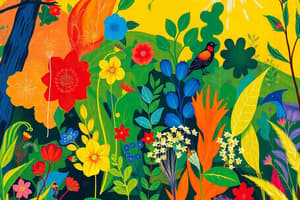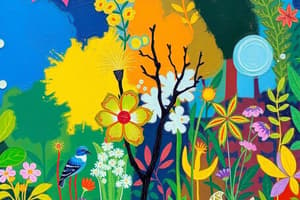Podcast
Questions and Answers
What is the largest land animal in India?
What is the largest land animal in India?
- Asian elephant (correct)
- Indian rhinoceros
- Leopard
- Sloth bear
Where are the highest number of leopards found in India?
Where are the highest number of leopards found in India?
- Western Ghats (correct)
- Southern parts
- National parks
- Northern parts
What conservation measures are being taken in India according to the text?
What conservation measures are being taken in India according to the text?
- Building highways through natural habitats
- Construction of skyscrapers in wildlife areas
- Opening wildlife for unrestricted hunting
- Establishment of protected areas and community-based conservation programs (correct)
What are some of the threats to India's wildlife as mentioned in the text?
What are some of the threats to India's wildlife as mentioned in the text?
Which type of forest in India is characterized by drought-tolerant trees and shrubs?
Which type of forest in India is characterized by drought-tolerant trees and shrubs?
Which region of India is characterized by dense canopies and diverse wildlife?
Which region of India is characterized by dense canopies and diverse wildlife?
In which region of India are the highest density of tigers found?
In which region of India are the highest density of tigers found?
What type of forest is found in the Himalayan region of India?
What type of forest is found in the Himalayan region of India?
During which period did the Gupta Empire experience great prosperity and cultural achievement?
During which period did the Gupta Empire experience great prosperity and cultural achievement?
What cultural achievements were associated with the Gupta period?
What cultural achievements were associated with the Gupta period?
In which areas did the cultural influence of the Gupta Empire extend to?
In which areas did the cultural influence of the Gupta Empire extend to?
What were some technological advancements attributed to the Gupta Empire?
What were some technological advancements attributed to the Gupta Empire?
During the Post-Gupta period, what characterized the emergence of regional powers and the flourishing of local cultures?
During the Post-Gupta period, what characterized the emergence of regional powers and the flourishing of local cultures?
What were some of the regional powers that emerged in the Indian subcontinent after the decline of the Gupta Empire?
What were some of the regional powers that emerged in the Indian subcontinent after the decline of the Gupta Empire?
What were some of the cultural developments during the Post-Gupta period?
What were some of the cultural developments during the Post-Gupta period?
What marked the significance of the Gupta and Post-Gupta periods in the history of India?
What marked the significance of the Gupta and Post-Gupta periods in the history of India?
Flashcards are hidden until you start studying
Study Notes
SST: India - Natural Vegetation and Wildlife
Introduction
India is known for its diverse and rich natural vegetation and wildlife. This article provides a comprehensive overview of the natural vegetation and wildlife found in India, including various types of forests, grasslands, wetlands, and the unique wildlife species that inhabit these habitats.
Natural Vegetation
India has a wide variety of natural vegetation types, including:
-
Tropical Rainforest: Found in the Western Ghats and the Andaman and Nicobar Islands, these forests are characterized by their dense canopies and diverse wildlife.
-
Tropical Dry Deciduous Forest: Covering the Central Indian region, these forests are characterized by their dry conditions and deciduous trees that shed their leaves during the dry season.
-
Tropical Dry Forest: Found in the semi-arid regions of India, these forests are characterized by their drought-tolerant trees and shrubs.
-
Tropical Thorn Forest: Found in the arid regions of India, these forests are characterized by their thorny trees and shrubs.
-
Mountain Forest: Found in the Himalayan region, these forests are characterized by their high altitude and diverse vegetation types.
Wildlife
India is home to a diverse range of wildlife, including:
-
Tigers: India is home to about 70% of the world's tiger population, with the highest density of tigers found in the Sunderbans.
-
Elephants: India has the largest population of wild elephants in the world, with about 27,000 individuals.
-
Asian Elephant: The Asian elephant is the largest land animal in India and is found mostly in the southern parts of the country.
-
Rhinoceros: India is home to both the Indian rhinoceros and the one-horned rhinoceros, with the latter being found mostly in the northern parts of the country.
-
Leopards: India is home to about 12,000 leopards, with the highest number found in the Western Ghats.
-
Bears: India is home to five species of bears, including the Asiatic black bear and the sloth bear.
-
Monkeys: India is home to several species of monkeys, including the Hanuman langur, the common langur, and the bonnet macaque.
Threats and Conservation
Despite the rich natural vegetation and wildlife in India, these resources face numerous threats, including habitat loss, poaching, and human-wildlife conflicts. Some conservation measures being taken in India include the establishment of protected areas, such as national parks and wildlife sanctuaries, and the development of community-based conservation programs.
Conclusion
India's natural vegetation and wildlife are a testament to the country's rich biodiversity. By understanding and conserving these resources, we can ensure that future generations can continue to enjoy the beauty and diversity of India's natural heritage.
Studying That Suits You
Use AI to generate personalized quizzes and flashcards to suit your learning preferences.




